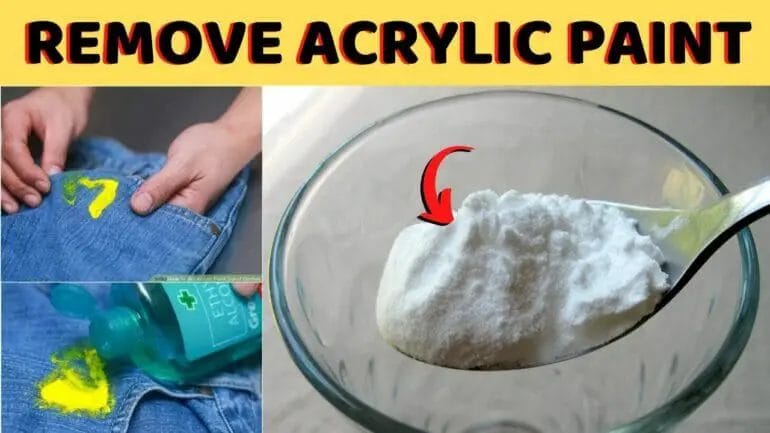Wondering how long it takes for acrylic paint to dry on fabric? Look no further! Acrylic paint is a versatile medium for adding vibrant colors to your fabric creations. The drying time can vary depending on various factors such as the thickness of the paint, humidity, and the fabric type. Generally, acrylic paint on fabric takes about 24-48 hours to dry completely, but it is always recommended to check the specific instructions on the paint label for accurate drying times.
To speed up the drying process, you can use a hairdryer on a low-heat setting or place the fabric in a well-ventilated area. Keep in mind that heat setting the paint with an iron after it is dry can also help to make it more permanent on the fabric. Remember, patience is key when working with acrylic paint on fabric – giving it ample time to dry will ensure a long-lasting and vibrant result for your creative projects.

Tips for speeding up the drying time of acrylic paint on fabric
Acrylic paint is a versatile medium that allows artists to paint on various surfaces, including fabric. While acrylic paint offers many benefits, such as vibrant colors and durability, it can take some time to dry on fabric. If you need to speed up the drying time of acrylic paint on fabric, here are some tips to help you:
1. Thin layers
Applying thin layers of acrylic paint will allow them to dry faster. Thick layers of paint take longer to dry, as the moisture within the paint needs to evaporate. When painting on fabric, use a brush or roller to apply thin, even coats of paint, allowing each layer to dry completely before applying the next.
2. Use a hairdryer
A hairdryer can be a useful tool for accelerating the drying time of acrylic paint on fabric. Set the hairdryer to a low or medium heat setting and direct the airflow over the painted surface. Be sure to keep the hairdryer at a safe distance from the fabric to prevent any damage.
3. Increase air circulation
Improving the air circulation around the painted fabric can help expedite the drying process. Open windows or doors to allow fresh air to circulate through the room. You can also use a fan to create a breeze, which will help dry the paint faster.
4. Use a fabric medium
Adding a fabric medium to your acrylic paint can help speed up the drying time and improve the paint’s adherence to the fabric. Fabric mediums are specifically formulated to mix with acrylic paint and enhance its flow and drying characteristics. Follow the manufacturer’s instructions when using a fabric medium.
5. Avoid high humidity
High levels of humidity can significantly extend the drying time of acrylic paint on fabric. Try to avoid painting on fabric during periods of high humidity. If possible, choose a dry, well-ventilated area to work in.
6. Heat-set the paint
Heat-setting can help accelerate the drying time and improve the permanence of acrylic paint on fabric. After the paint has dried for at least 24 hours, place a pressing cloth over the painted area and iron it on a low heat setting for a few minutes. This process will help set the paint and make it more resistant to washing and fading.
7. Use a drying medium
There are drying mediums available that are specifically designed to accelerate the drying time of acrylic paint. These mediums can be mixed with your acrylic paint before applying it to the fabric. Follow the instructions provided by the manufacturer for the best results.
By following these tips, you can speed up the drying time of acrylic paint on fabric. Remember to always read and follow the instructions provided by the manufacturer of the acrylic paint and any additional mediums or additives you may be using. With proper techniques and preparation, you can create beautiful and vibrant artwork on fabric with acrylic paint.

How to properly prepare and prime fabric before using acrylic paint
Acrylic paint is a popular choice for artists and crafters due to its versatility and vibrant colors. Painting on fabric can yield stunning results, whether you’re creating a custom-designed t-shirt or adding artistic touches to a textile project. However, to ensure the best outcomes and longevity of your artwork, it is essential to properly prepare and prime the fabric before applying acrylic paint. In this section, we will discuss the step-by-step process of preparing and priming fabric to achieve excellent results with acrylic paint.
1. Choose the Right Fabric
The first step in preparing fabric for acrylic paint is selecting the right type of fabric. Not all fabrics are suitable for painting, as some may not absorb the paint properly or result in a less desirable finish. Ideally, you should choose a fabric that is made of natural fibers, such as cotton or linen, as these fabrics tend to work best with acrylic paint. Synthetic fabrics like polyester or nylon can also be used, but they may require additional preparation.
2. Pre-Wash the Fabric
Before you start priming the fabric, it is crucial to pre-wash it to remove any sizing, dirt, or chemicals that may interfere with the paint’s adhesion. This step helps to ensure that the paint adheres to the fabric evenly and prevents any unwanted reactions with the paint. Follow the fabric’s care instructions and use a mild detergent to wash the fabric. Avoid using fabric softeners, as they can leave a residue that hinders paint absorption.
3. Iron the Fabric
After the fabric is clean and dry, it is essential to iron it to eliminate any wrinkles or creases. Ironing the fabric not only creates a smooth surface for painting but also helps the paint adhere better. Set your iron to the appropriate heat setting for the fabric type and ensure that it is free from any water or steam, as this can affect the paint’s application.
4. Apply Fabric Medium
Using a fabric medium is a vital step in preparing fabric for acrylic paint, especially when working with natural or synthetic fabrics. A fabric medium is a type of additive that helps to improve the paint’s adhesion and flexibility on fabric surfaces. Mix the fabric medium with your acrylic paint according to the manufacturer’s instructions. This will create a more durable and washable finish, preventing the paint from cracking or peeling over time.
5. Prime the Fabric
Priming the fabric is an optional step but highly recommended, especially when working with lighter-colored fabrics or when you want to achieve more opaque colors. A fabric primer helps to create a barrier between the fabric and the paint, allowing the paint to adhere better and enhancing the color’s vibrancy. Apply a thin, even layer of fabric primer to the entire surface using a brush or roller. Allow the primer to dry completely before proceeding to paint.
6. Begin Painting
Now that your fabric is properly prepared and primed, you can start applying the acrylic paint. Use a brush or sponge applicator to create your design or apply the paint as desired. It is advisable to start with light layers and build up the intensity as needed. Allow each layer to dry before applying additional coats to avoid smudging or mixing of colors. Once you’ve completed your artwork, let it dry completely before moving or wearing the fabric.
By following these steps to properly prepare and prime fabric before using acrylic paint, you can ensure that your artwork or custom designs on fabric turn out beautifully and have longevity. Remember to choose the right fabric, pre-wash and iron it, apply fabric medium, and consider priming the fabric for the best results. Happy painting!

The impact of different factors on the drying time of acrylic paint on fabric
Acrylic paint is a versatile medium that is commonly used on various surfaces, including fabric. When painting on fabric with acrylics, it is important to consider the factors that can affect the drying time of the paint. Understanding these factors can help artists achieve the desired results and ensure that the paint adheres properly to the fabric.Type of fabric
The type of fabric used can significantly impact the drying time of acrylic paint. Fabrics with a tighter weave, such as cotton or linen, tend to absorb the paint more quickly, resulting in faster drying times. On the other hand, fabrics with a looser weave, such as silk or chiffon, may take longer to dry as they do not absorb the paint as readily. It is important to consider the fabric’s absorbency and adjust painting techniques accordingly.Humidity and temperature
Humidity and temperature play a crucial role in the drying time of acrylic paint on fabric. High humidity levels can slow down the drying process, as moisture in the air hinders evaporation. Similarly, lower temperatures can also prolong drying time. It is best to paint in a well-ventilated area with moderate humidity and temperature conditions to ensure optimal drying.Thickness of paint application
The thickness of the paint application can also affect drying time. Thicker layers of paint will naturally take longer to dry compared to thin layers. If a quick drying time is desired, artists can apply thin layers of paint and allow each layer to dry before adding additional layers. This approach helps prevent the paint from becoming too saturated and prolonging the drying process.Use of additives
Certain additives can be used to alter the drying time of acrylic paint on fabric. Retarders or extenders can slow down the drying process, allowing artists more time to work with the paint. Conversely, drying agents can speed up the drying time, which can be useful when working on time-sensitive projects. It is important to carefully follow the instructions provided by the manufacturer when using additives to ensure desired results.Air circulation and drying techniques
Proper air circulation is essential for quick and even drying of acrylic paint on fabric. Artists can use fans or open windows to create airflow, which helps facilitate evaporation and reduces drying time. Additionally, using heat sources such as hairdryers or heat guns can expedite the drying process. However, caution must be exercised to avoid overheating the fabric or causing the paint to bubble or crack. In summary, several factors can influence the drying time of acrylic paint on fabric. The type of fabric, humidity and temperature levels, thickness of paint application, use of additives, and air circulation all play a role in how quickly the paint dries. By understanding these factors, artists can make informed decisions and employ techniques that best suit their desired outcomes. Experimentation and practice will further enhance an artist’s understanding of how these factors interact, enabling them to achieve optimal results when working with acrylic paint on fabric.Exploring alternative methods to accelerate the drying process for acrylic paint on fabric
Acrylic paint is a popular choice for artists and crafters due to its versatility and vibrant colors. However, one common challenge that artists face when working with acrylic paint on fabric is the drying time. Unlike other mediums, acrylic paint can take a while to fully dry on fabric, which can be frustrating when you’re trying to complete a project quickly.
In this section, we will explore alternative methods that can help accelerate the drying process for acrylic paint on fabric, allowing you to finish your projects in a timely manner.
1. Heat Setting
One effective method to speed up the drying time of acrylic paint on fabric is heat setting. Heat setting involves using an iron or a heat press to apply heat and pressure to the painted fabric, which helps to bond the paint to the fibers and expedite the drying process.
Here’s how you can heat set acrylic paint on fabric:
- Allow the paint to dry completely for at least 24 hours.
- Place a piece of cloth or parchment paper over the painted area.
- Set your iron to the appropriate temperature for the fabric.
- Gently press the iron onto the painted area for a few seconds, applying even pressure.
- Moving the iron in circular motions, continue to apply heat to the entire painted surface.
- Remove the cloth or parchment paper and let the fabric cool down.
Heat setting can help to fix the paint onto the fabric and reduce the overall drying time.
2. Air Circulation
Another method to speed up the drying process for acrylic paint on fabric is to improve air circulation around the painted surface. Increasing airflow can help evaporate the moisture from the paint, allowing it to dry faster.
Here are some ways to enhance air circulation:
- Use a fan to create a breeze in the room where the fabric is drying. Direct the fan towards the painted surface to encourage faster drying.
- Hang the fabric up in a well-ventilated area, such as near an open window or outdoors (if weather permits). The exposure to fresh air can aid in the drying process.
- If possible, use a dehumidifier in the room to reduce humidity levels, as high humidity can prolong the drying time of acrylic paint.
By improving air circulation, you can expedite the drying time of acrylic paint on fabric.
3. Fabric Medium
Adding a fabric medium to your acrylic paint can not only enhance its adhesion to fabric but also help reduce the drying time. Fabric mediums are specially formulated additives that improve the flow and workability of acrylic paint on fabric.
Here’s how you can use a fabric medium:
- Mix the acrylic paint with the fabric medium according to the manufacturer’s instructions.
- Apply the paint mixture to the fabric using a brush, sponge, or any desired application method.
- Allow the paint to dry completely, following the recommended drying time specified by the fabric medium.
Fabric mediums not only accelerate the drying time but also ensure that the paint remains flexible and durable on fabric.
4. Thin Layers
When working with acrylic paint on fabric, applying thin layers can help expedite the drying process. Thick layers of paint take longer to dry and may remain tacky for an extended period.
Here are some tips for applying thin layers:
- Dilute the acrylic paint with water or a paint extender to create a more fluid consistency.
- Apply multiple thin layers of paint, allowing each layer to dry completely before adding the next one.
- Avoid overloading the brush with paint, as this can lead to thicker applications.
By applying thin layers of acrylic paint, you can reduce the drying time and achieve better results on fabric.
5. Use a Hairdryer
If you’re in a hurry and need to speed up the drying process, using a hairdryer can be a convenient option. The warm air from the hairdryer helps evaporate the moisture from the paint, allowing it to dry faster.
Here’s how you can use a hairdryer to accelerate the drying of acrylic paint on fabric
FAQs
How long does acrylic paint take to dry on fabric?
The drying time for acrylic paint on fabric can vary depending on various factors such as the thickness of the paint, humidity, and temperature. Generally, it takes around 24 to 48 hours for acrylic paint to fully dry on fabric. However, it is recommended to allow the painted fabric to dry for at least 48 hours before washing or wearing to ensure proper adhesion and durability.
Conclusion:
In conclusion, the drying time of acrylic paint on fabric varies depending on several factors. Generally, it takes around 24 to 48 hours for acrylic paint to completely dry on fabric. However, this drying time can be influenced by the thickness of the paint layer, humidity levels, and the fabric’s absorbency. To speed up the drying process, you can use a hairdryer on low heat or place the fabric in a well-ventilated area. It’s important to allow the paint to dry completely before handling or washing to ensure the longevity of your painted fabric.
Acrylic paint offers vibrant colors and durability on fabric, making it a popular choice for various art and craft projects. Remember to follow the manufacturer’s instructions for drying times and any additional steps, such as heat-setting, which can further enhance the paint’s permanence on fabric. With proper care and patience, you can create stunning and long-lasting designs on fabric using acrylic paint.
